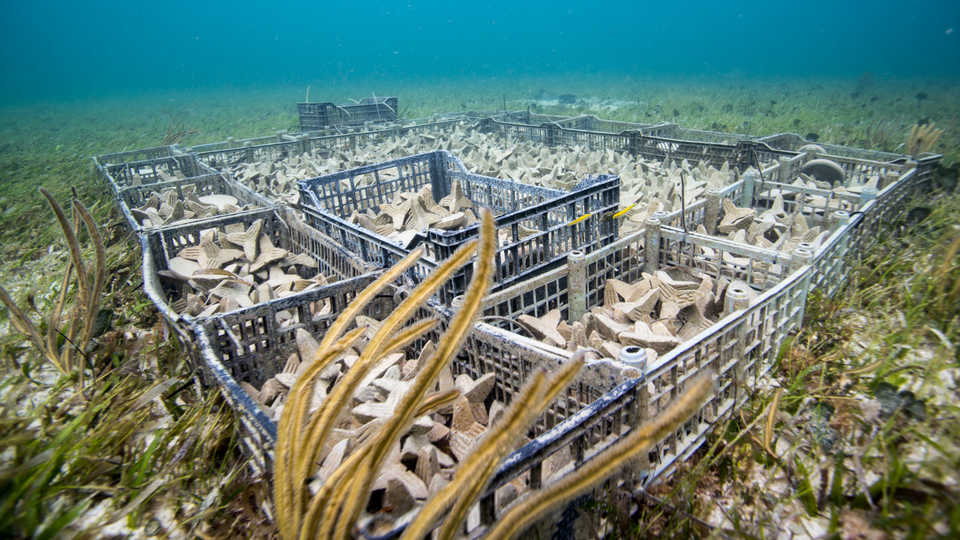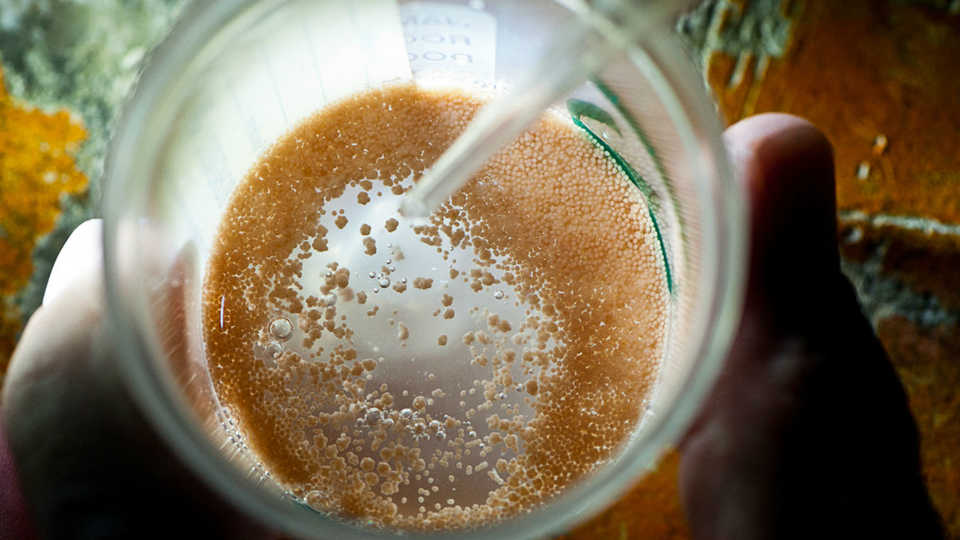As part of its Hope for Reefs initiative, the California Academy of Sciences joins forces with SECORE International and The Nature Conservancy to implement large-scale coral restoration
SAN FRANCISCO (April 11, 2017)— A powerhouse group of scientists and conservationists are joining forces to tackle the unprecedented decline of coral reefs worldwide. The California Academy of Sciences, SECORE International, and The Nature Conservancy are sealing their commitment to help rehabilitate coral reefs and preserve them for future generations by spearheading the Global Coral Restoration Project, a global project that combines conservation, education, and outreach efforts to study and restore reefs on a large scale—starting with Caribbean reefs in Mexico, Curaçao, and the U.S. Virgin Islands.
This partnership is part of the Academy’s recently launched Hope for Reefs initiative—a groundbreaking effort to research, restore and raise awareness about coral reef systems around the world for which the institution has raised more than $13 million to date. In addition to exploring some of the least-known coral reefs in the world to learn more about how these systems currently function, Academy scientists are focused on predicting how they will fare in the future and aiding in their conservation. This collaboration with SECORE and The Nature Conservancy represents a meaningful step forward for restoration efforts in our planet’s most threatened coral reefs.
By "seeding" reefs with sexually reproduced coral offspring (a cutting-edge, on-the-reef approach), the Global Coral Restoration Project will help maintain corals' genetic diversity and maximize their ability to adapt to future conditions. The collaboration offers training for partners from island nations and territories—including organizations capable of translating their efforts into local management plans that support this large-scale coral restoration initiative. The project starts in the Caribbean and is planned to expand into the Pacific region after its initial phase.
Restoring invaluable ecosystems
Nearly 75% of the world’s coral reefs are currently threatened by the combined impacts of overfishing, habitat destruction, water pollution, climate change, and ocean acidification. SECORE, the Academy, and a growing group of partners and supporters have spent years researching ways to leverage corals’ natural sexual reproduction to restore struggling reef ecosystems.
Though they represent less than 0.1 percent of global oceans, coral reefs—the most diverse marine ecosystems on Earth—provide significant marine habitat for countless animals. Reefs provide vital ecological services that support the livelihood and well-being of billions of people worldwide. All told, it is estimated that coral reefs provide human societies with vital goods and services worth several hundred billion dollars per year.
In the Caribbean with a novel approach
“The threats facing coral reefs are so gigantic that we need a monumental, coordinated effort to fight reef decline like never before,” says Bart Shepherd, Director of Steinhart Aquarium and Hope for Reefs co-leader. “SECORE’s new scientific and stakeholder-training approaches to restoring reefs will help break through the time and labor constraints that have slowed past conservation efforts. We’re aiming to seed one million global corals by 2021.”
Over decades of regional work, scientists from the three partner organizations have gathered profound knowledge about coral reproduction and the practice of restoring Caribbean corals. The Nature Conservancy has worked throughout the Caribbean for more than 40 years, helping to perfect restoration efforts and establish millions of acres of marine protected areas. SECORE’s use of sexually-produced corals in restoration efforts—a fascinating process in itself—has undergone an incredible transformation after more than ten years of research.
Coral reefs are built over time by large colonies of tiny animals called stony coral polyps. These immobile animals release their eggs and sperm into the water column—often in mass spawning events that occur roughly once per year.
“When ocean conditions are poor,” says Shepherd, “reef-building corals are unable to successfully reproduce. Conservation scientists have developed ways of sexually producing large quantities of coral offspring that are genetically diverse and are raised on land and in ocean-based nurseries. We literally plant these reproduced corals on reefs using self-attaching concrete pieces shaped like tetrapods.”
During the past few years, the project partners have studied how to raise large numbers of delicate coral larvae of several Caribbean species, practiced less labor-intensive ways of seeding coral recruits on reefs, developed protocols to choose suitable restoration sites, and learned how to efficiently monitor ongoing restoration success. Because key reef-building species, including elkhorn and staghorn corals, are critically endangered, one focus of this collaborative project will be to assist in their rehabilitation.
Sharing knowledge
The Global Coral Restoration Project will work to transfer these unique hands-on restoration techniques to local stakeholders, a vital exchange given the severity of threats facing global reefs. The partners will establish three capacity-building centers in the Caribbean: in Mexico, Curaçao, and the U.S. Virgin Islands. At each location, a local team of experts will test and refine sexual reproduction techniques and share findings with coral reef practitioners around the world. Project partners emphasize that coastal stakeholders who rely upon reefs are critical to making any restoration and conservation efforts truly successful over time.
The first task of the new alliance? A kick-off workshop called “New techniques for coral restoration in the Caribbean” on Curaçao this May. Interdisciplinary scientists and stakeholders throughout the Caribbean will meet to learn hands-on practices—including collecting and fertilizing coral gametes and practicing the handling of larvae to be seeded onto degraded reefs—and share theoretical background knowledge.
Changing the coral reef story from “tragedy to hope”
“The Academy’s support has added critical staff and resources to SECORE’s world-changing work,” says Shepherd. “Beyond our support of new scientists in critical field locations in the Caribbean, the Academy’s goal is to help advance restoration science and expand conservation training workshops around the globe. The portfolio of methods and technology we’re building are meant for a wide variety of corals across a wide variety of reef habitats. We are doing everything we can to change the coral reef story from tragedy to hope.”
Already global leaders in this field, the Academy will continue to develop and apply science-based technologies to increase survival of coral reefs on a global scale. Together with a growing network of partners, the Academy’s unique mix of scientific expertise, world-leading ocean exploration skills, on-the-ground conservation efforts, world-class aquarium and coral culturing facilities, and innovative educational platforms will give critical marine ecosystems the science-based help—and global attention—they deserve.
The Academy's Hope for Reefs initiative is made possible through the support of visionary donors. The Academy gratefully acknowledges the lead partners listed below.
- William K. Bowes, Jr. Foundation
- Dalio Ocean Initiative
- Eva and Bill Price
- Jennifer Caldwell and John H. N. Fisher
- Wendy and Eric Schmidt
The Institute for Biodiversity Science and Sustainability at the California Academy of Sciences is at the forefront of efforts to understand two of the most important topics of our time: the nature and sustainability of life on Earth. Based in San Francisco, the Institute is home to more than 100 world-class scientists, state-of-the-art facilities, and nearly 46 million scientific specimens from around the world. The Institute also leverages the expertise and efforts of more than 100 international Associates and 400 distinguished Fellows. Through expeditions around the globe, investigations in the lab, and analysis of vast biological datasets, the Institute’s scientists work to understand the evolution and interconnectedness of organisms and ecosystems, the threats they face around the world, and the most effective strategies for sustaining them into the future. Through innovative partnerships and public engagement initiatives, they also guide critical sustainability and conservation decisions worldwide, inspire and mentor the next generation of scientists, and foster responsible stewardship of our planet.
Press Contacts
If you are a journalist and would like to receive Academy press releases please contact press@calacademy.org.
Digital Assets
Hi-res and low-res image downloads are available for editorial use. Contact us at press@calacademy.org to request access.

